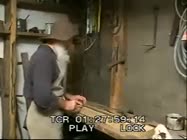Restoring a traditional English scythe: turning new nibs
When looking at traditional scythes for sale, the older type of English scythe is not so easy to spot amongst the endless ubiquitous American/Canadian imports to which English blades were fitted. This old beauty, which came from the Norfolk area, is in good original conditon, despite the wood having rotted through. Taking such an old thing apart is a form of archaeology and a real link to our past, which I find very exciting.
English scythe nib- (or dole-) irons were commonly secured to the stem with iron/steel wedges, unlike American 'twist-grip' nibs which pull and tighten their 'iron' loop around the snath. It requires a little extra effort/skill to work with wedges; they can loosen and fall out, so you have to check them often on new sneaths until things have bedded in, and again if the wood may have dried out for any reason. But when you get the hang of it you may find that a simple wedge is so effective that you wonder why it wasn't thought of earlier ...
The remnants of the old sneath look like 7-year-old willow or alder (I counted the rings!) which, being weaker wood, would explain the large (1 3/4", 45mm) hoops on the nib-irons. These particular nibs are an example of lathe-turned handles - suited to mass-manufacturing, but not quite as comfortable as the more ergonomic range of handles that could be bought in Britain in the past or, of course, crafted by the mower himself. I was a little surprised at the large diameter of the wooden part of the nib (1 5/8", 42mm) and its length too, but perhaps this is telling of how lifelong heavy manual labour led to some big hands!
The sneath at the end of the video is made from ash - if I get some suitable willow in the future, I'll try that too.
note:
sneath = snead = snath = sned = pole = handle etc.
nib = dole = grip etc.






















